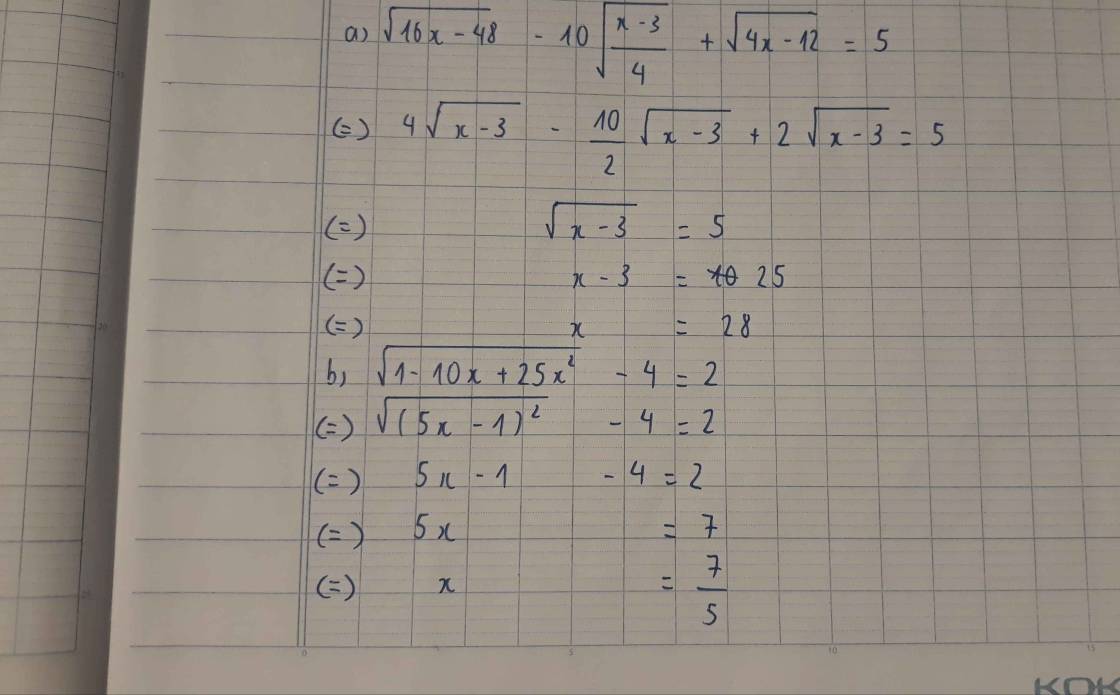Hãy nhập câu hỏi của bạn vào đây, nếu là tài khoản VIP, bạn sẽ được ưu tiên trả lời.

b) (4√x + 4)/(x + 2√x + 5) ≥ 1
⇔ (4√x + 4)/(x + 2√x + 5) - 1 ≤ 0
Do x ≥ 0 ⇒ x + 2√x + 5 > 0
⇒ (4√x + 4)/(x + 2√x + 5) - 1 ≤ 0
⇔ (4√x + 4) - (x + 2√x + 5) ≤ 0
⇔ 4√x + 4 - x - 2√x - 5 ≤ 0
⇔ -x + 2√x - 1 ≤ 0
⇔ -(x - 2√x + 1) ≤ 0
⇔ -(√x - 1)² ≤ 0 (luôn đúng)
Vậy (4√x + 4)/(x + 2√x + 5) ≤ 1 với mọi x ≥ 0
a: \(P=\dfrac{x+8\sqrt{x}+8-x-4\sqrt{x}-4}{\sqrt{x}\left(\sqrt{x}+2\right)}:\dfrac{x+\sqrt{x}+3+\sqrt{x}+2}{\sqrt{x}\left(\sqrt{x}+2\right)}\)
\(=\dfrac{4\left(\sqrt{x}+1\right)}{x+2\sqrt{x}+5}\)
b: 4(căn x+1)>=4
x+2căn x+5>=5
=>P<=4/5<1

a.\(A=\dfrac{x^2-4x+4}{x^3-2x^2-\left(4x-8\right)}=\dfrac{\left(x-2\right)^2}{x^2\left(x-2\right)-4\left(x-2\right)}=\dfrac{\left(x-2\right)^2}{\left(x^2-4\right)\left(x-2\right)}=\dfrac{x-2}{\left(x-2\right)\left(x+2\right)}=\dfrac{1}{x+2}\)
\(A=\dfrac{\left(x-2\right)^2}{x^2\left(x-2\right)-4\left(x-2\right)}\left(x\ne\pm2\right)\\ A=\dfrac{\left(x-2\right)^2}{\left(x-2\right)^2\left(x+2\right)}=\dfrac{1}{x+2}\\ B=\dfrac{x+2-x+\sqrt{x}-1}{\left(\sqrt{x}+1\right)\left(x-\sqrt{x}+1\right)}\cdot\dfrac{4\sqrt{x}}{3}\left(x>0\right)\\ B=\dfrac{4\sqrt{x}\left(\sqrt{x}+1\right)}{3\left(\sqrt{x}+1\right)\left(x-\sqrt{x}+1\right)}=\dfrac{4\sqrt{x}}{3\left(x-\sqrt{x}+1\right)}\)

\(a,C=\dfrac{2x^2-x-x-1+2-x^2}{x-1}\left(x\ne1\right)\\ C=\dfrac{x^2-2x+1}{x-1}=\dfrac{\left(x-1\right)^2}{x-1}=x-1\\ b,D=\dfrac{1+\sqrt{a}}{\sqrt{a}\left(\sqrt{a}-1\right)}\cdot\dfrac{\left(\sqrt{a}-1\right)^2}{\sqrt{a}+1}\left(a>0;a\ne1\right)\\ D=\dfrac{\sqrt{a}-1}{\sqrt{a}}\)
Có

a) \(ĐKXĐ:x\ne-\sqrt{3}\)
\(=\dfrac{\left(x-\sqrt{3}\right)\left(x+\sqrt{3}\right)}{x+\sqrt{3}}=x-\sqrt{3}\)
b) \(=\dfrac{1-\sqrt{a^3}}{1-\sqrt{a}}=\dfrac{\left(1-\sqrt{a}\right)\left(1+\sqrt{a}+a\right)}{1-\sqrt{a}}=1+\sqrt{a}+a\)

a) đkxđ x≥0 , x ≠1
\(K=\left(\dfrac{\left(\sqrt{x}-1\right)\left(\sqrt{x}+1\right)}{\left(\sqrt{x}-1\right)\left(\sqrt{x}+1\right)}-\dfrac{4\sqrt{x}}{\left(\sqrt{x}-1\right)\left(\sqrt{x}+1\right)}+\dfrac{\left(\sqrt{x}+1\right)}{\left(\sqrt{x}-1\right)\left(\sqrt{x}+1\right)}\right):\dfrac{\sqrt{x}\left(\sqrt{x}-2\right)}{\left(\sqrt{x}-1\right)\left(\sqrt{x}+1\right)}\)
= \(\dfrac{x-1-4\sqrt{x}+\sqrt{x}+1}{\left(\sqrt{x}-1\right)\left(\sqrt{x}+1\right)}.\dfrac{\left(\sqrt{x}+1\right)\left(\sqrt{x}-1\right)}{\sqrt{x}\left(\sqrt{x}-2\right)}\)
= \(\dfrac{x-3\sqrt{x}}{\sqrt{x}\left(\sqrt{x}-2\right)}=\dfrac{\sqrt{x}\left(\sqrt{x}-3\right)}{\sqrt{x}\left(\sqrt{x}-2\right)}=\dfrac{\sqrt{x}-3}{\sqrt{x}-2}\)b)
\(\dfrac{\sqrt{x}-3}{\sqrt{x}-2}=\dfrac{\sqrt{x}-2-1}{\sqrt{x}-2}=1-\dfrac{1}{\sqrt{x}-2}\)
để K ∈ z thì \(\dfrac{-1}{\sqrt{x}-2}\) nguyên
=> √x -2 ∈ Ư(-1)={-1;1}
=> x ∈ {1; 9}
vậy ...

a: \(=\dfrac{x-1-4\sqrt{x}+\sqrt{x}+1}{x-1}\cdot\dfrac{x-1}{x-2\sqrt{x}}\)
\(=\dfrac{x-3\sqrt{x}}{x-2\sqrt{x}}=\dfrac{\sqrt{x}-3}{\sqrt{x}-2}\)
b: Để K là số nguyên thì \(\sqrt{x}-2-1⋮\sqrt{x}-2\)
=>\(\sqrt{x}-2\in\left\{1;-1\right\}\)
hay x=9
c: Để K là số âm thì \(\dfrac{\sqrt{x}-3}{\sqrt{x}-2}< 0\)
=>4<x<9

a,\(x\ge\dfrac{3}{2}\)
\(\dfrac{\sqrt{2x-3}}{\sqrt{x-1}}=2\)\(=>2\sqrt{x-1}=\sqrt{2x-3}\)
\(< =>4\left(x-1\right)=2x-3< =>4x-4=2x-3< =>x=0,5\left(ktm\right)\)
\(=>x\in\phi\)
b, \(đk:\left[{}\begin{matrix}x< 1\\x\ge\dfrac{3}{2}\end{matrix}\right.\)
\(=>\sqrt{\dfrac{2x-3}{x-1}}=4< =>\dfrac{2x-3}{x-1}=>4\left(x-1\right)=2x-3\)
\(< =>4x-4=2x-3< =>2x=1=>x=\dfrac{1}{2}\left(tm\right)\)
vậy,,,..
